Edgar Allen Poe
1850/6: The Works of Poe
The Works of the Late Edgar Allan Poe were published in the U.S. (1850 & 1856), although sadly
edited by someone who sometimes freely rewrote and recombined the stories. Poe (1809-1849)
had been known in his own lifetime — but only as a critic,
not as a writer of fiction.
Poe's works, along with de Sade and the recovery
of European folk/fairy tales, became the seeds of a sophisticated gothic imagination (there had been an
unsophisticated
pre-1848 literature of 'Penny Dreadfuls' and a brief British craze for horror stage shows)
— which can be seen running through Stevenson's
Hyde (1886), the 'L'Esprit Decadent' novels of the 1880s, James'
The Turn of the Screw (1898),
Ernst's collage novels, Lovecraft, Mervyn Peake, Borges,
Ray Bradbury, Angela Carter, to Jan Svankmajer and beyond.
← return to index
Oscar Gustave Rejlander
1857: "The Two Ways of Life".
Working in Wolverhampton, Oscar Rejlander took six weeks to create a seamless combination print from 32 negatives.
Loosely based on a classical theme, there were two versions — both complex high Victorian tableaux. They depict the life-choices of a young man, Industry or Dissipation.
It was first shown at the Manchester Art Treasures Exhibition of 1857, when many objected to the nudity. But Royal patronage followed, and
Rejlander moved to London and made his name as "the father of art photography". His later
The Bachelor's Dream (circa 1860) is an almost proto-surrealist staged picture.
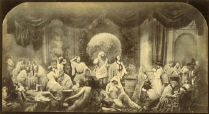
← return to index
Henry Peach Robinson
1858: "Fading Away".
Robinson's famous combination print, "Fading away" (1858), pictured a young girl's death due to TB; a common occurrence that undoubtedly contributed to
the Victorian cult of childhood. In 1859 he published a booklet,
On printing photographic
pictures from several negatives. A more detailed book followed in 1869, and then
Picture Making by Photography (1884).
He became an eloquent advocate for art photography, but Gernsheim (
Creative Photography, 1962) shows he preferred the "scissors & paste-pot"
rather than combination printing for most prints. Robinson helped found The Linked Ring.
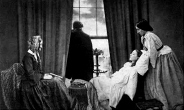
← return to index
H.D Fredericks & Co.
1858-1889: collaged group portraits
Fredericks took Fox Talbot's process to the U.S. — from 1858 his New York studio specialised
in collaged 'group portrait' cartes de visite, and trick images. Also in the U.S., William Notman
composited groups (e.g.: "Skating Carnival" 1870).




← return to index
Fantastic stereos
1860s onwards: stereo publishers.
The craze for stereos educated the visual imagination of the public to see pictures as
made of elements held in "layered planes", although the plane-like nature of stage scenery would
already have laid the groundwork for such an understanding of fantastic display.
"In the 1860s and subsequent decades publishers of binocular photographs, such as the London Stereoscope Co. and the
American firm Underwood & Underwood, marketed an entire series of ethereal ghosts, angels and fairies for the amusement
of the public." — from:
The Perfect Medium, p.52.
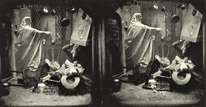
← return to index
Alice
1865: Lewis Carroll publishes Alice.
Lewis Carroll, a photographer since 1856 and a good friend of Oscar Rejlander (see
1857), published
his famous book
Alice's Adventures in Wonderland. The book had a strong and continuing influence on the visual
imagination. Carroll later made the influential "Xie" pictures, 1868-1879. Rediscovered and properly printed from the early 1970s,
Carroll's main photographic/literary subject matter — girlhood and the sleeping/dream state — has become a common theme in contemporary work.
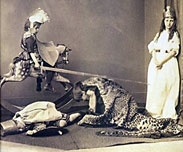
← return to index
Domestic collage
1860s & 70s: assemblage collages.
As fine engravings proliferated in affordable printed material, a practice of amateur collage grew up among
affluent girls and women in the industrialising world. The products of this domestic craft — unusual and distorted images
inside 'scrap' albums and on fire-screens filled with re-combined chromolithographs, engraved prints, and even original domestic photographs —
would have been known only to their family and intimate social circle. But the practice nevertheless ran in parallel to the
standard photography of the time, and it may have informed the craze for surreal combination printing in the 1880s.

← return to index
Spirit levitation
1872: Frederick Hudson
Frederick Hudson's "Spirit Photograph" (1872) can be seen in the left picture below. This is the first known spirit photograph that shows the 'levitation' of a table. The levitation
happens in the presence of a man and a 'spirit'. Levitation and flying is a theme that is dominant in
contemporary nu-real photography; possibly this arises out of seeing a handful of key Lartigue photographs, but in most cases it probably also
reflect an awareness of early spirit photography.
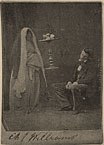

← return to index
Combination printing
1880s: Fashionable fakes
New photographic processes meant that more people could make photographs. Amateurs
experimented with 'amusing' techniques that were previously marvelled at.
The approach became extremely fashionable, and combination portraiture amounted to 'a craze' — Francis Galton (1822-1911) being a leading British practitioner.
Very few examples of this 'craze' survive from the 1880s, so it is difficult to know how 'fantastic'
some of the pictures were or how long the craze really lasted. The interest in photographic
trickery had sufficient momentum, however, to push Woodbury's book
Photographic Amusements (1896)
through 11 editions from 1896 to 1937.

← return to index
Fantastic fiction
1880s onwards: genres of combination and accumulation
Popular 'fantastic' genres emerged in literature: Sir Arthur Conan Doyle's
A Study in Scarlet (1887) (first Sherlock Holmes); Robert Louis Stevenson's
Dr. Jeckyll & Mr. Hyde (1888); H.G. Wells'
The Time Machine (1895)
Bram Stoker's
Dracula (1897). A deep and enduring tradition of British children's fantasy literature
began to take root, with George MacDonald's
At the Back of the North Wind (1871) and Lewis Carroll's
Through the Looking Glass (1871).
In France 'L'Esprit Decadent' produced a new macabre fiction. In the U.S., Poe was re-evaluated and re-published.


← return to index
La Nature
1893: Surreal photomontage
Surreal photomontages were published in the French
La Nature (1893), republished in
Scientific American, and then included in Woodbury (1896). In
some of the images we can perhaps see the influence of Carroll's
Alice. The pictures appear on pages 132-134 of
LN and are headed "Recreations Photographiques"
and credited to an "M. R. Riccart", now unknown. Old copies of
La Nature would later provide a fertile mine of ideas for Max Ernst (see Krauss, The
Optical Unconscious).
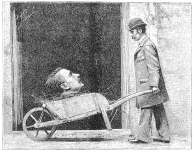
← return to index
The new show windows
1900: Trimming the marvellous
In 1900 L. Frank Baum — the author of
The Wizard of Oz (1900) — published
the monumental and influential manual
The Art of Decorating Dry Goods Windows (1900). Techniques of tableaux staging, mannikins
and stage magic were combined to create the shop "illusion windows" (see: Colver 1988); eruptions of the marvellous and implicitly erotic into everyday life,
overlaid with layers of mirrored reflections (analogous to photomontage) in the newly affordable plate glass. Baum was editor of the journal
Show Windows from 1897-1902.
The surrealists were later fascinated by Atget's Paris show window photographs, although these do not convey the effect of being
lit at night — in Berlin in the 1910s and 20s, the new show windows were lit up at night, and 'the uncanny mannikins' seen there, perhaps fed the early German cinema's
fascination with 'living' automata and robots.
← return to index
Trick photography
"Operated by any school boy or girl!" — Kodak marketing, 1901
Once cheap Brownie cameras started to get into the hands of intelligent young people after 1900, further layers of inventiveness emerged. This was aided
by practical manuals of trick photography, such as Woodbury's
Photographic Amusements (1896),
Chaplot's
La Photographie Recreative et Fantaisiste (1902), and Walter Eagleson's
Trick Photography (1902).
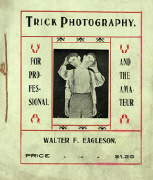
← return to index
The growing girl
'Blended' garden photography
A minor theme in the popular 'trick' home photography of the early 1900s appears to have been straight photography of girls appearing to blend with / emerge out of the foliage of a garden.
This was possibly influenced by the children's fantasy literature of the period?
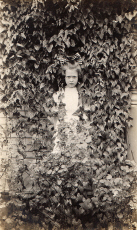
← return to index
Surreal seaside photography
A head, a hole, a 'trick' photo
From around 1900 until the early 1980s painted wooden boards were a common feature of seaside promenades and piers.
A photograph of the board would be taken with a person's head in a hole, thus creating a 'trick' photograph. The paintings used were often somewhat fantastic in nature.
Millions of people would have seen this simple method of using photography to create a fantastical picture.
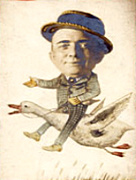
← return to index
The boy Lartigue
Jacques Henri Lartigue, 1902 ~
Jacques Henri Lartigue created some of his most important 'trick' flying / levitating pictures from 1902 to about 1906. These included:
"Zissou as a ghost" (1902); "Cousin Bichonnade in flight" (1905); "Zissou's first attempts at flying" (1905); and "My Nanny" (1904). His work only became
widely known and published from the late 1960s and early 1970s. With this theme, he appears to contribute one of the major themes to the contemporary nu-real —
although he was himself influenced by spirit photography.
Lartigue worked in stereo, a process that views pictures as if made up of elements suspended in "layered planes"; perhaps a spur to the appreciation of photomontage.

← return to index
British postcards
Eccentric and mesmerist postcards
Popular photographic postcards circulated in Britain, showing fantastic scenes — such as the "If London were Venice" (circa 1902), part of a series.
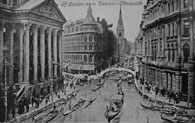
'Hypnotised and suspended' (c. 1901)...
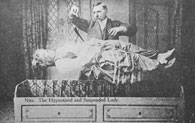
← return to index
German postcards
Fantasy head-paste photomontages
Popular German postcards used bizarre combinations such as those below, from 1902-05. Enlarged or swopped heads is an easy
but effective technique; and are also seen in the films of Georges Melies.
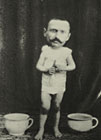

← return to index
German postcards
Propaganda postcards
Below is a pungent 1905 example of anti-British propaganda in a German postcard — a decade before John Heartfield
'invented' political photomontage in Germany.

← return to index
French postcards
Political(?) photomontage postcards
'Out at last' is a circa-1905 photomontage postcard from France, which possibly had political meaning to people at the time.
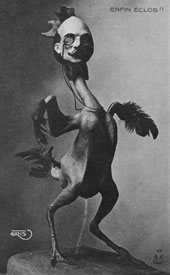
← return to index
American postcards
1908-1913: William H. Martin
'Fantastic farming' postcards circulate in the U.S. William H. "Dad" Martin, having run a photography studio in Kansas since 1894, turns to making
a series of humourously surreal photomontaged postcards showing farmers hunting giant rabbits and farmers taking
huge potatoes or geese to market. These appear to have been first produced by him in 1908, and Martin continued
making and selling them until about 1912 or 1913, when he sold his very profitable new business.
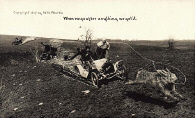
← return to index
German erotic postcards
Gerlach & Martin Gerlach Jr., 1911
Below are two examples of the polished erotic photomontage postcards that were circulating in Germany before the First World War.
Can the Dada-ists, so attuned to the erotic and the scandalous, really have been unaware of polished work
such as this, or the fantasy postcards they would have grown up with, when they variously claimed to have 'invented' photomontage?


← return to index
Futurist photodynamism
1911-13: Anton Giulio Bragaglia
Bragaglia created a ghostly — almost spirit photography -like — photography of movement and blurring that he
terms "photodynamism". He writes:
"A shout, a tragical pause, a gesture of terror, the entire scene, the complete external unfolding of
the intimate drama, can be expressed in one single work." — "Fotodinamismo Futurista" (1913).
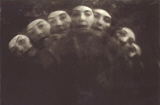

← return to index
Fake fairies
1917-1920: the "Cottingley fairies"
Sisters Elsie Wright (aged 16) and Frances Griffiths (aged 10) created five photographs that purported to show the girls with fairies and a gnome. Amazingly, the
photographs sparked decades of heated debate over their authenticity. It is likely that the photographs were created using painted cardboard cut-outs held up with tacks.
Elsie (seen below) went on to work in a photography studio, creating composite pictures of fallen First World War British soldiers with their loved ones.
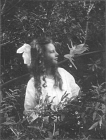
← return to index
Dada photomontage
1916-1918: German dada 'invents' photomontage
The date of the 'invention' of photomontage is commonly claimed to have been in May 1916 in Germany, by George Grosz and John Heartfield; although their description of the event sounds
more like a crude political collage of elements that happened to include some photographs from the German illustrated press.
Fellow dadaists Raoul Hausmann and Hannah Hoch
made a slightly more convincing claim to have 'invented' photomontage in 1918, apparently having seen how ordinary people were sticking cut-out photos of the face of their
loved-ones onto
"a coloured lithograph of a grenadier in front of barracks".
← return to index
German cinema
1918-1920: 'Combined' creatures
Cinema matured as an expressive medium during the First World War. German cinema created a new visual horror around the idea of 'artificial' or 'constructed' monsters, such as
Der Golem (1914), the
Homunculus series (1916~),
Alraune (1918) and
Der Golem (1920); and
'constructed' fantastic landscapes, such as in
The Cabinet of Dr Caligari (1919).

← return to index
Max Ernst's collages
Engraving composites, 1919-1924
Max Ernst discovered the process of surreal collage in 1919, using Victorian engravings (many originally made from photographs), ...
"I was struck by the obsession which held under my gaze the pages of an illustrated catalogue ... It was enough at that time to
embellish these catalogue pages, in painting or drawing, and thereby ... transformed into revealing dramas my most secret desires
from what had been before only some banal pages of advertising." Ernst credited Max Klinger (1857-1920), a Symbolist painter,
as the inspiration for his collages. Many of Ernst's collages might better be
termed composites - because many strive for a seamless consistency.

← return to index
Magischer Realismus
Germany, 1920
From 1920 German painters added small dream-world and eerie fragments to a new realist art whose subject matter
nevertheless remained firmly within the boundaries of the possible. Other traits of 'Magischer Realimus' were said to be
"absence of timidity with regard to
painting the unpleasant" ...and ...
"a new spiritual relationship with the world of things" (Weiland Schmeid).
The German art critic Franz Roh first used the term 'Magischer Realimus' to describe the major "Die Neue Sachlichkeit"
exhibition in June 1925. Roh would later publish a book of seventy avant-garde photographs,
Foto-Auge (1929) — in which
he would point to the photomontages included, and suggest photomontage as being
"the ideal formal solution" to the deployment of the imagination in photography.
← return to index
Magischer Realismus
Overlaps with surrealist painting
Salvador Dali, Rene Margritte and Paul Delvaux produced paintings with the photographic clarity of magic realism. Magritte was
strongly influenced by photographers, notably Paul Nouge — Roegiers (2005) shows how... "his work often began in a viewfinder".
Margritte had an exhibition of his own photographs in Munich in 1977.
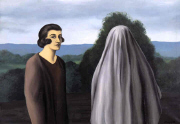
Interestingly, Dali told Hitchcock (for
Spellbound, 1945) that dreams in film should
be portrayed in a sharp focus, rather than by using the then-typical 'soft-focus and fog' approach.
← return to index
Max Ernst's collages
Engraving composites, Paris 1921
The '1st Dada fair' was in 1920. Ernst's collages had their first exhibition, at the Galerie Au Sans Pareil in Paris (1921), under the auspices of
Andre Breton. This period of his creative work culminated around 1924, when
the surrealists issued the first
Manifesto of Surrealism (1924).


Ernst's collage work particularly influenced artists such as Jindrich Styrsky (1899-1942) and
Joseph Cornell (1903-1972).
← return to index
Devetsil
Czechoslovakia, 1921-29
Originating in Prague in Oct 1920, Devetsil was the main avant-garde force there. Its photographers broke from pictorialism to create
"mysterious, darkly erotic and haunting imagery ... breaking from themes of the past to visualize poetry" (
Paris Voice review of
'Beaute Modern', Sept 1998). The Devetsil credo was: "Within a minimum of time, generate a maximum of speed, and taste all the beauty of the world" and also to
free art of political ideology and to blend it with everyday life (Teige). It readily accepted collage. Eclectic and loosely organised, it influenced Czech Surrealism, Fotoline and the surrealist
photomontagist Jindrich Styrsky, and the post-war photographs of Vilem Reichmann. After 1948 those who had led Devetsil, such as Karel Teige, were persecuted by the communists.
Only after the overthrow of communism did Devetsil — and the real history
of Czech photography and collage — become known in the West.
← return to index
At the Bauhaus
Germany, 1922
Some photomontages were made at the Bauhaus — Laszlo Moholy-Nagy created around sixty photomontages from circa 1922 (interestingly, while sharing a studio with Kurt Schwitters).
While Moholy-Nagy's photocollages show a Soviet Constructivist influence, many strive to appear seamless and internally coherent;
and in some of the works he used fantastic composites to express his emotional inner life.
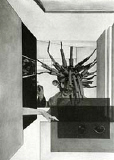
← return to index
Surrealist photography
Manifesto of Surrealism, 1924
Surrealist photography officially began with the publication of Andre Breton's
Manifesto of Surrealism (1924).
Double exposure, solarisation, distortion, shadows, reflections, and extreme close-up all became
common approaches. Such photographs, and 'found' photography, are widely used in surrealist publications.
While surrealism clearly shows how art can be made from a dark and anxious eroticism...
"The surrealist photographers (Man Ray, Raoul Hausman, Bill Brandt, Brassai, etc.) rarely used photomontage."
— from:
Photographic Conditions of Surrealism (1984), and...
"comparatively few surrealists persisted with photomontage after initial experiments"
— from: Ades,
Photomontage (1976). An interesting mid 1930s exception is Dora Maar.
Surrealist films, especially
Un Chien Andalou (1928) and
L'Age d'or (1930), may have influenced
photomontage.
← return to index
Belgian photomontage
Albert Valentin, 1929
While the major surrealist photographers
"rarely used photomontage", a few
Paris surrealists such as Georges Hugnet (1904-1974) did. It was the Belgian surrealists, such as Paul Joostens (1886-1960)
and Albert Valentin (1908?-1968?), who more fully explored surrealist photomontage (as did those in Prague, and the Englishman Roland Penrose).
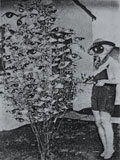

This 'eyes' picture by Valentin was published in the avante-garde art magazine
Varietes; Belgium, 1929.
← return to index
Collage novels
Max Ernst, 1929-1934
Max Ernst published three surreal collage-novels, created from magazine and book engravings, some of which originated in photographs.
These books were
La Femme 100 Tetes / (Woman of 100 Heads) (1929);
Reve d'une Petite Fille qui voulut entrer au Carmel / (A Little Girl Dreams of Taking the Veil) (1930); and
Une Semaine de Bonte / (A Week of Kindness) (1934).

In 1930, Aragon wrote an essay, for a retrospective show in Paris of collage works, in which he deplored the lack of critical interest in collage activity.
← return to index
In advertising
Britain and Germany, post 1919
Simple photomontage, and graphic combinations of photographs, had begun to be used in the illustrated popular press
of Britain and Germany. This was a trend which had been apparent from since before the First World War. Inevitably, the loss of men during the Great War,
and later the Depression, caused publishers seek easier and cheaper sources of pictures than illustrators. Then the process started to gain
mass acceptance — the professional journal
The Printers Ink of Dec 1929, carried the four-page article "The Photomontage: A
New Illustrative Technique"
by Douglas Crawford McMurtrie. In 1929 some imaginative photomontage was commissioned by German pen&ink company Pelikan, from members of the
Circle of New Advertising Designers. But most pre-war examples were bland and un-fantastic. Photomontage was only introduced into U.S. advertising in the early 1940s, by Paul Rand.
← return to index
The Berlin retrospective
Berlin, 1931
A major exhibition was staged in Germany in 1931, showing the first retrospective of dada and surrealist photomontage —
Fotomontage, at the Kunstgewerbemuseum, Berlin.
Gustavovich Klucis published a major essay advocating photomontage as "A New Kind Of Agitational Art" (1931).
In the coming years the technique would become a polished political tool in the hands of John Heartfield (1891-1968). However
right-wing nationalists also became adept at the technique, such as Jan Polinski in Poland. Futurists such as Renato Fazioli also used photmontage (see his "Le scale", 1932)
Constructivists also used the juxtaposition technique of photocollage for propaganda in Soviet Russia,
tightly integrated with graphic design. Lissitzky and Rodchenko produced photocollage as early as 1922, and the approach became
popular in Russia from 1924/5 until the 1930s.
← return to index
Herbert Bayer
Berlin, 1931-32
Herbert Bayer studied at the Bauhaus from 1921 to 1928, and then worked in Berlin for his own design firm.
From about 1931 Bayer started to make a series of well-known seamless photomontages such as: "Language of Letters" (1931); "Bone Breaker" (1931)
"Self Portrait In A Mirror" (1932); and "The Lonely Metropolitan "(1932).

On 6th-10th May 1933 the library of the Institut fur Sexualwissenschaft was burned on the Opernplatz in Berlin — the first of many
Nazi book burnings.
← return to index
Jindrich Styrsky
Edition 69
Max Ernst's
Reve d'une Petite Fille (1930) has similarities to Carroll's
Alice stories, but filtered through a Sadeian imagination. This collage-novel
inspired Jindrich Styrsky's collage-illustrated
Edition 69 journal (1931-40?) and its Czech translation of
Justine. Privately printed
and distributed to subscribers, Styrsky's publication was a distinctively Czech devetsil-surrealist investigation of erotic drives. Below is
one of the collages from Styrsky's series "Emilie Comes to Me in a Dream", which accompanied
his erotic dream-writing.
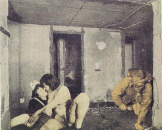
← return to index
Doll photography
Die Puppe (The Doll), 1934
Bellmer published his book
Die Puppe (
The Doll) in 1934, followed
by a Dec 1934 two-page article in the surrealist
Minotaure, "Doll: Variations on the Montage of an Articulated Minor".
The Doll was published in Paris in 1936. In 1936 in the U.S., Morton Bartlett began his staged tableaux with dolls
(1936-1963). Such photography later influenced Bernard Faucon, Anthony Goicolea and the Chapman 'hybrids'. Themes from
this uncanny erotic puppetry seem to influence some contemporary nu-real photographers.

← return to index
Two works by Magritte
La Gacheuse 1935, and L'Invention collective, 1934
Rene Magritte was influenced strongly influenced by photographers, notably Paul Nouge — Roegiers (2005) shows how... "his work often began in a viewfinder".
In 1934 and 1935 Magritte produced two paintings that seem to be strongly influenced by photomontage.


← return to index
Dora Maar
Le simulateur (1936)
Simple two-picture photomontage by Dora Marr (1907-1997). Upside-down photograph of a sewer interior, with the boy pasted onto it.
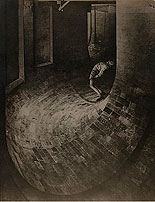
← return to index
William Mortensen
L'Amour 1937
William Mortensen was inspired by lurid pulp magazine covers, Symbolist art, and an American interpretation of Freud. Mortensen was a strong advocate of
manipulated photography in the USA during the 1930s, but despite his technical expertise he was later airbrushed from the history of photography when the first of the histories were published.
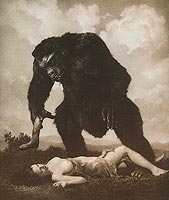
← return to index
Herbert List
Fotografia Metafisica, 1933-38
Around 1933, the German gay photographer Herbert List began to experiment with a surrealist-influenced approach to photography
that in 1936 — having reached the safety of London and then Greece — he would term
fotografia metafisica.
Using double-exposures and mirrors, curtains, masks, shadows, constructed scenes and sleeping boys, List explored the erotic dream state.
Due to the invasion of Greece he was forced to return to Germany in 1941.




← return to index
Pierre Boucher
DIY manuals, 1937-41
This image of a hand and lake was apparently created by Boucher especially for the book by
Marcel Natkin,
Fascinating Fakes in Photography (1939). The text notes the need for seamless lighting of all elements, and that two
arms were stuck to the print to obtain the reflection. A little later,
Crazy Camera: Secrets of Photomontage (1941) was published by Focal Press, London.
In the U.S., a translation of Croy's German photomontage manual
Hunderterlei Kotokniffe (1936) was published in 1937.
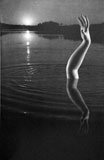
← return to index
Clarence John Laughlin
A surrealist in the U.S.
Clarence John Laughlin (1905-1985) began to photograph from 1930, in architectural and fashion photography.
Fascinated by the Poe-esque grand ruined houses in the southern states,
he used these for photographic constructions featuring costumed models. He published
a book,
Ghosts Along the Mississippi, in 1948 but his visionary work had almost no recognition during his lifetime.





← return to index
Joseph Cornell
Soap Bubble Set onwards, 1936
In 1936 Joseph Cornell created the first of his interactive assemblage boxes.
Until he began his boxes, Cornell's work had been in
Max Ernst -inspired collages, as seen at Julien Levy's Surrealist group show (Jan 1932, New York)
and at Barr's later group show (MoMA, 1936). Cornell did not cease to work in this manner once he started the boxes; as shown by the Cornell-edited
"Americana Fantastica" edition of
View
magazine (2nd series, No.4, Jan 1943). Cornell also made own sensual 'cut-up' films (
Rose Hobart, 1936), and
later made poetic dreamlike films with Stan Brakhage.

← return to index
Edmund Teske
Composite prints, 1936-40 onwards
Edmund Teske (1911-1996) began art photography in 1936, and in the late 1930s taught at the
New Bauhaus in Chicago with Moholy-Nagy. Living in Los Angeles, and operating on the fringes of the art world, his
finely-printed homoerotic composite prints were despised by critics — but some were shown in L.A. in the 1950s.
He appears to have stopped photographing in 1959/60
— instead reprinting earlier images and teaching at UCLA. Many of his homoerotic photographs were not seen until 2004.

← return to index
Kenneth Anger
Fireworks (1947), Rabbit's Moon (1950), montage and queer pop art
Film-maker Kenneth Anger, who had been the subject of a photomontage portrait by Edmund Teske (see left), created the dreamlike Melies-inspired film
Rabbit's Moon (1950).
Later exploring the same areas of erotic film-collage as Joseph Cornell and Stan Brakhage, Anger's famous collage film
Scorpio Rising (1964) segwayed with the queer invention of pop art and the re-invention of collage (see: Warhol, Hockney,
Burroughs, even Robert Smithson's collages, et al).

← return to index
Val Telburg
Born in Russia in 1910, Telberg (1910-1995, born Vladimir Telberg-von-Telheim) left for the U.S. in 1928. He worked as a maker of comic photographs
at an amusement park. He was influenced by the surrealists when they arrived in New York
at the start of the Second World War. Telberg began serious photography in 1945, using recombination and cinematic overlays, sometimes making large mural-sized prints.
His photographs illustrated a 1958 U.S. re-issue of Anais Nin's slim dream-journal
House of Incest (1936, 1947 in English) by Swallow Press.
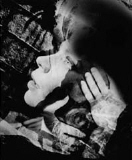
← return to index
Philippe Halsman
"Dali Atomicus", 1948
Dali and fashion/celebrity photographer Philippe Halsman collaborated to create several surreal photographs,
notably "Dancer" (1947), "Dali Atomicus" (1948) and "In Mors Voluptate" (1951). The pictures, which
might otherwise have been created by photomontage, were actually purely 'straight'
shots. Their collaboration culminated in the photography book
Dali's Mustache (1954).
However, by that time surrealism was effectively silent, and Dali's name would become a 'dirty
word' in art schools for nearly 50 years.
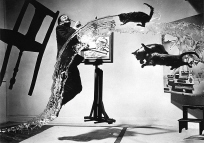
← return to index
Grete Stern
Suenos ('Dreams'), 1948-1951
The German emigre Grete Stern (1904-1999) lived and worked in Argentina from 1935,
and from 1948 to 1951 published a series of 140 photomontages, now known as the Suenos
('Dreams') series. They illustrated a regular magazine
column called "Psychoanalysis can help you", which appeared the Argentinian women's magazine
Idilio.
Largely ignored as an artist, her 140 works were first seen together at a 2003 gallery exhibition in Buenos Aires.

← return to index
Harry Callahan
Pictures made in the early 1950s
Primarily a street and family photographer, Callahan also experimented with multiple exposures and playful trick photography, but produced
only a few finished prints each year. Also a teacher, Callahan taught photography at the Institute of Design in Chicago (1946-) and the Rhode Island School of Design (-1977).
The picture below, "Eleanor", is from 1951.
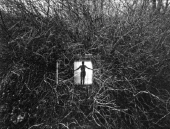
← return to index
Toshiko Okanoue
Japan, 1950-1956
Using images cut from
Vogue and
Life magazines, fashion student Okanoue created
surreal photomontages that "fit my dreams". Okanoue had a solo show in Japan in 1953, but ceased
making pictures after 1956.
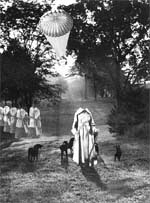
← return to index
Georges Hugnet
Hugnet continues creating photomontage, 1950s
The surrealist Georges Hugnet, expelled from the Surrealists by Breton in 1939 after joining in 1932, continued to make
seamless erotic photomontage after the end of the Second World War.
Hugnet apparently maintained contact with Conroy Maddox in Birmingham, England.


See:
Georges Hugnet: Collages (168 color and b&w illustrations), published in Paris in 2003.
← return to index
Surrealism, a "spent force"
Cold post-war realities
As the English-speaking world came to terms with the end of the Second World War, from the early 1950s surrealism was widely seen as
a "spent force" in art, and intellectually dead. This belief
was heavily promoted by the French Communist Party.
British neo-romanticism in painting was also considered "spent". Pockets of surrealists, such as the Birmingham (England) surrealists and Birmingham's Conroy Maddox (1912-2005),
strove to continue creating new
work, including photocollage.
In 1956 there was a major Balthus exhibition at the MoMA in New York. The press refered to
the paintings as "strange tableau" and the unfashionable words 'surreal' or 'surrealism'
do not appear to have passed their lips.
The E.C. horror comics range was effectively banned in the U.S. in 1954.
← return to index
The dying of the light
Classic fantasy fiction
A series of powerful 'cultural depth-charges' were dropped into the darkness of the 1950s and early 60s — fantastic fiction that 'burned on a very long fuse', but which would ultimately explode in the minds of the
generation of 1967. The first three books of T.H. White's
The Once & Future King were republished after the war. Mervyn Peake's
illustrated
The Hunting of the Snark (1941) was followed by his
Titus Groan (1946)
Gormenghast (1950), introducing post-war teenagers
to a grotesque and gothic imagination of a high order. Tolkien's
Lord of The Rings trilogy had been
published by 1954, but had an indifferent reception.
Ray Bradbury's
Dandelion Wine (1957) and
Something Wicked This Way Comes (1962) were potent American explorations
of fantastic childhood dreams and nightmares respectively. The first English translation of Borges
appeared in 1961,
Ficciones.
← return to index
Trip the light fantastic
A resurgence of interest in fantasy and the surreal, 1967 to 1979
A new worldwide youth subculture started to take an avid interest in fantasy literature, fairy-tales,
gothic horror, science-fiction, and surreal/visionary art. During the early 1970s
there were new scholarly publications on dada and surrealism, fantasy illustrators, the Symbolists, and the
Pre-Raphaelites. Nabokov published
Ada or Ardor (1969).
The West Coast surrealist movement began in the U.S. in 1965 following the 1964 MoMA show, with
photomontage by Gary Lee Nova and Bill Bissett, and
Limbo magazine from 1964. (In 1978, the West Coast Surrealists were invited to
Surrealism Unlimited, an exhibition organized in London by Conroy Maddox. By 1985 the West Coast
had produced Ernst-like collagists such as Debra Taub, Hal Rammel, Patrick Turner, Vivian Torrence, and Freddie Baer.)
← return to index
Photomontage rediscovered
Cut outs and cut-ups
The Beatles'
Sgt. Pepper album (1967) featured on the front cover the "People We Like"
photomontage by Peter Blake, bringing photomontage to millions.
Terry Gilliam's surreal cut-out animations appeared on British TV from 1967-1974, most famously in
Monty Python, and these frequently
used Victorian and Edwardian photography and engravings.
The new and camp Pop Art revived the art of the collage and photomontage — although in its garishness it might be seen to feed more into the
later manipulated photography of Gilbert & George and Pierre et Gilles, rather than into nu-real.


← return to index
Alice in Wonderland
Jonathan Miller's Alice in Wonderland (1966)
This b&w film, produced and directed by Miller, was broadcast in the late evening (because
"surreal and disconcerting", etc.) on British
television on 28th Dec 1966, and repeated in 1967.
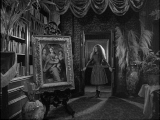
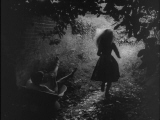
← return to index
Jerry Uelsmann
Solo show at MoMA, 1967
Starting to photograph around 1953 and influenced by Minor White, Uelsmann created "multiple printing" work in the darkroom from 1965.
In 1967 Szarkowski gave him a one-man show at MoMA. In 1973 an issue of
Aperture was
devoted to his work, accompanying a one-man show at the Philadelphia Museum of Art. Uelsmann's visionary photomontages became
much admired. Although, perhaps due to his advanced darkroom technique, it was not until
Photoshop
3.0 — 20 years later — that most admirers could imagine that they might also create such pictures.
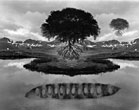

← return to index
Duane Michals
'Sequences', late 1960s onwards
In a fresh photographic sequencing, such as
Paradise Regained (1968),
The Fallen Angel (1968),
The Human Condition (1969), and
The Bogeyman (1973), Michals (1932-) pictured fantastic
dreams and nightmares.

Interestingly this narrative storytelling form recalled a form of popular culture — the comic strip — which had been
one of the few easily-available sources of 'the visual fantastic' during the 1950s and 1960s. The form had also been used by Magritte (
Man with a Newspaper, 1928). Michals' early photographic sequences
were published in book form as
Sequences in 1970.
← return to index
Arthur Tress
Dream Collector 1969-1972, and onwards
New York photographer Arthur Tress (1940-) began his
Dream Collector series in 1969, creating
fantastic images from children's memories of their dreams. His later work continued to explore this area.


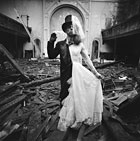
← return to index
Misha Gordin
Shadows Of The Dream, 1972 ~
Misha Gordin (1946-) created a darkroom combination printing method to construct his images
or enhance his darkly fantastic staged images. At first working in Latvia under a totalitarian communism that he despised and refused to collaborate with, his new work (1972 onwards) was not understood
or approved of — but in 1974 he escaped to freedom in the U.S.
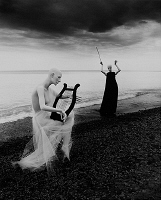
← return to index
Mari Mahr
Mari Mahr, mid 1970s onwards
Living in London after her family escaped from Budapest in 1972, Mahr seems to have begun making photomontages from the
the mid 1970s onward (?). Her work contains themes of personal childhood identity and loss, and her personal
experience of anti-semitism in communist Hungary.
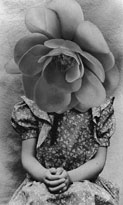
← return to index
From the cellars of communism
Jan Saudek, mid 1970s onwards
Living in communist Prague after having survived the concentration camps, Saudek worked in a clandestine manner in a cellar to avoid the attentions of the secret
police. His pictures used implicitly political symbols of corruption and
innocence. From the late 1970s he was widely
seen by the West's new university-trained photographers. His work is a constructed portrayal of painterly dream worlds in tableaux form, often inhabited by nude
or semi-nude figures surrounded by bare plaster walls or painted backdrops, and often re-using identical elements.


← return to index
Opening the archives
Early British photography re-discovered, early 1970s onwards
From around 1972, a long scholarly effort began to recover and properly publish early photography.
In Britain, this was only able to succeed due to the opening up of major archives such as the
Royal Photographic Society from the early 1970s, and access to the 300,000 photographs at the
Victoria & Albert Museum in London from the mid 1970s. Much of this scholarship (Ovenden, Harker, Haworth-Booth, et al) was published in book
form, which became an increasingly viable form of dissemination of photographs from the early 1970s onwards. The pictures, often stripped
of much original context, could look strange and other-worldly.
From this eventually came a renewed interest in antique photographic processes, setting the stage for their contemporary application.
See the book
Photography's Antiquarian Avant-Garde: The New Wave in Old Processes (2002).
← return to index
Rene Groebli
Switzerland, early 1970s
Rene Groebli (1927-) created a series of about twelve dream photomontage pictures that were published in the book
Dreams (n.d.).
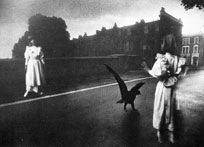
← return to index
Ralph Eugene Meatyard
The Family Album of Lucybelle Crater & Aperture monograph, 1974
'Discovered' by Jonathan Williams, Stan Brakhage and Guy Davenport in 1965, Meatyard died in 1972.
Although there had been a collection in book form in 1970, his uncanny and grotesque photography came to wide attention with his book
The Family Album of Lucybelle Crater (1974),
and an Aperture double-issue/book of his pictures (1974).
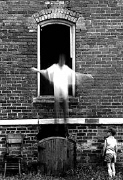
← return to index
Francois Caillon
France, 1974/5
Francois Caillon (1954-) created dream-scene photomontages in the mid 1970s, published in
the French
Contrejour magazine. The works go far beyond the cliched approach to making
'ersatz-surreal arty nude pictures' that became tediously common during the 1970s.
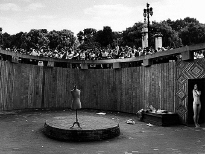
+ Angela Carter published her translation of
The Fairy Tales of Charles Perrault (1977), and
her book of dark fairy stories
The Bloody Chamber (1979).
← return to index
Fantastic photography
Exhibitions and books, 1976-1979
Two touring exhibitions were curated by the Canon Photo Gallery in Amsterdam —
Fantastic Photography in the U.S.A (1976)
and
Fantastic Photography in Europe (1976). These substantial shows appear to have toured throughout Europe, and
the 80-page catalogue for
Fantastic Photography in Europe sold out three editions.
Following this success, 1979 saw the publication of a 150-page book by Attilio Colombo titled
Fantastic Photographs —
"The first book of its kind in the field of photography, this
startling collection of work by an international group of young photographers probes the subliminal
recesses of the mind to create a new visual reality"
Photography critic A.D. Coleman published the 208-page
The Grotesque in Photography: A First Collection of Photographers Whose Fantastic Visions of Life Are as
Revolutionary as Those of Impressionists (1977).
← return to index
Fantastic painting, book illustration, and fiction
Fantasy resurgent, 1977-1979
Between 1979 and 1979 key books on painting and illustration appeared:
Fantastic Painters (1977);
The Fantastic Art of Vienna (1978);
Fantastic Illustration and Design in Britain, 1850-1930 (1979). The 'First International Conference on the Fantastic' was held in 1980. The 288-page
Dictionary of
Fantastic Art was published in 1981.
From 1979 onwards, some book-length surveys of erotic art start to include small amounts of homoerotic art, previously omitted.
The French
Metal Hurlant magazine was published in English from 1977, and became widely available — providing abundant stimulus to
young fantasy artists. 98% of fantasy art produced thereafter would be deeply cliched and shallow,
but artists such as Zdzislaw Beksinski and H.R. Giger would show what it was still capable of.
← return to index
The new gay tableaux
New photographic approaches, 1977-1979
From about 1977/8, major gay artists such as Gilbert & George (UK) and Pierre et Gilles (France)
discovered new hand-painted approaches to trangressive tableaux photography.


In 1979 Derek Jarman released the feature-film
The Tempest, a gothic work whose ending nevertheless
borrows from the camp tableaux photography of Pierre et Gilles. Jarman went on to play a major role
in the establishment of that most queer and often fantastic experimental medium,
the pop video.
The rediscovery of Eisenstein (a gay man, who invented a new cinematic language of fast montage)
in France in the 1970s may also have influenced the pop video.
← return to index
Ruth Thorne-Thompson
early 1980s onwards?
Ruth Thorne-Thompson made small pinhole dream-pictures of constructed worlds,
often with specific reference in their toning to 19th century photography.
One of her pictures from 1983, seen below, is "Man Levitating".
 Staged photography:
Staged photography: From around 1980, until the fall of the Berlin Wall, there was a
wave of 'staged' (often dream-like/absurdist) photography made (although not always widely seen) across Eastern Europe.
A more leaden and ideology-freighted staged photography was explored in Western Europe & the U.S. during the 1980s.
During the late 1980s and 90s fashion photography began to make inventive staged photography, on large budgets.
← return to index
The political 1980s
Photomontage in the UK
Following Linder's photomontage for the Buzzcocks (
Orgasm Addict, 1977) and others, there was a short period when British political photomontage was an active form,
in the hands of Peter Kennard and the crudely grotesque 'photocopied posters' artists associated with
Class War and the Anticopyright Network. Although, for the most part, the range of output was known
only to anarchists and anti-nuclear campaigners until the works were collected in book form:
Flyposter Frenzy, 1992;
and Kennard's
Images for the End of the Century, 1990.


← return to index
Joel-Peter Witkin
Grotesque tableaux, 1980-82 ~
Witkin (1939-) had his first show, in Paris in 1981. Like Saudek, Faucon and Helnwein, Witkin pointed the way
back to stage-like tableaux as the most apt mode for a pre-
Photoshop
fantastic, and echoed Saudek's use of antique techniques
to aestheticise the grotesque and transgressive.
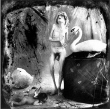
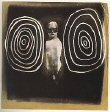
← return to index
Sarah Moon
Le Petit Chaperon Rouge, 1983
Fashion photographer Sarah Moon's
Le Petit Chaperon Rouge (1983) was published in Paris, using fantastic photography by Moon to
illustrate the classic dark fairy story by Perrault.


← return to index
Jan Svankmajer
The films of Jan Svankmajer
Svankmajer (1934-) has been making short films since the mid 1960s, and been a member of the Prague Surrealist Group since 1969.
In 1972 the communist regime effectively banned him from making films. Yet he managed to make adaptations of Carroll's
Jabberwocky
(1971), and Poe's
The Fall of the House of Usher (1980), among others. Many
of his films were banned. Jan Udhe (2005) wrote...
"The West ... appeared to be quite oblivious to his existence" until the early 1980s.
Channel 4 broadcast his films on British TV, and a major documentary about his work (1983).
In 1988 he produced his first feature-film, Carroll's
Alice, with funding from
Channel 4.

← return to index
Angela Carter
The Company of Wolves (1984)
British fantasy author Angela Carter's screenplay for
The Company of Wolves (1984, Dir. Neil Jordan) — based on Carter's book of
dark fairy stories
The Bloody Chamber (1979), and visually influenced by Carter's viewing of
Jaromil Jires's Czech surreal/symbolist feature-film
Valerie and Her Week of Wonders (1970)
and the Channel 4 showings of Svankmajer's films — resulted in a widely-seen feature-film
that deployed a deep symbolism within a loosely-plotted fantasy that drifts
between dream and realism.

+ From 1985 Francesca Woodman's photography becomes known in the U.S.
← return to index
The poetic vision
Recovery/translation, 1988-1990
U.S. publishers City Lights and Black Swan reprinted, translated, and published
new anthologies of surreal texts and poetry, easily available by mail-order from the late 80s. Many were illustrated by
Ernst-like collage by U.S. surrealists Debra Taub, Hal Rammel, Patrick Turner, and Freddie Baer.
In the late 1980s / early 90s, the U.S. alternative zine index
Factsheet Five
became a pre-web hub for access to strange zines and small presses.
FF's covers featured the collages of Freddie Baer; collected in book form by AK Press in 1991.
Good English translations of major surreal poets became easily available from the late 1980s,
such as Federico Garcia Lorca's
Poet in New York (1988), and Lorca's
Collected Poems (1988). A collection of poetry by
Odysseus Elytis was re-issued as a popular paperback;
The Sovereign Sun (1990).
← return to index
Lost paths recovered
Exhibitions and books, 1989
Following the 2nd revised edition of Dawn Ades's
Photomontage (1986), a deeper literature
began to emerge on the history of propagandist and art photomontage.
Scholarship began to recover a coherent narrative of late romantic art in
Britain. Two books on the British neo-romantics led to the major exhibition and book
The Last Romantics: Romantic Tradition in British Art (1989).
In the same year there was a major exhibition and book,
The Surrealist Spirit in Britain (1989).
Cheap printing in Eastern Europe meant that increasingly heavyweight full-colour books were landing on coffee tables from 1990 onwards. These include the 500-page
Lost Paradise: Symbolist Europe (1995), providing a sumptuous colour tour of
European symbolist art; and the exhaustive 540-page
Max Ernst Collages: The Invention of the Surrealist Universe (1992).
← return to index
A generation lost
Gay men's deaths from HIV/AIDS
The creative arts were decimated by the loss of a generation of creative talent,
due to HIV/AIDS. The peak years of death were 1988-1993. The disease probably killed
around 500,000 gay men in the U.S. alone.
Collage had a small role to play in coping and protest: in the sombre angry newspaper-cutting paintings and collage-assemblages made
by Derek Jarman in his last years at Prospect Cottage; in the Ernst-style collages and cut-out mask photography of David Wojnarowicz; in the photo-constructions of
Gilbert & George; in the ever-growing patchwork memorial quilts.
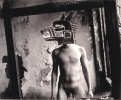
← return to index
Constructed realms
Computer games, 1993 onwards
With
Myst (1993) for the Mac, a potent new avenue for
the immersive expression of fantasy and uncanny symbolism emerged, influencing the visual imagination
of a new generation of young creatives. American McGee's dark and gothic
Alice in Wonderland (2000)
was a particularly accomplished highpoint that still has a cult following.
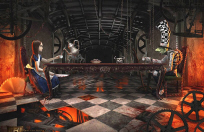
In this regard, the work of Ray Caesar points to a future when 'photo-real' tableaux
may be easily created in computer-game -like software rather than starting in a camera.
← return to index
Photoshop version 3.0, Nov 1994
version 3.0, Nov 1994
A plug-in program for
Photoshop
, 'Specular Collage', had added a layers function to
Photoshop
since mid-1993.
But the release of
Photoshop
3.0, with its native ability to layer and blend different images, provided a polished
tool to create seamless photocomposited images.
Affordable flatbed scanners became available (plus the cheap RAM needed to handle large scans), meaning that artists could easily scan in
found or public-domain material for collages.

Photoshop

3.0 with layers" />
← return to index
Web browers "see" images
Netscape, 1995
At around the same time that
Photoshop
put the means of production into the hands of artists, the means of distribution
of such images was also released — web browsers that could load images in web pages. However,
dial-up access was still painfully slow and monitors were small and fuzzy.
As the cost of fast PCs and net access plummeted, the stage was set for a new worldwide web of artistic influence;
a web that would link creatives who had never met one another, and which would also start to link deeply into searchable archives of images
and books — and 'free' pirated software. However, the web increased pressure on creatives; we had to ask if we were
making work good enough to be shown on a world stage.
It took until about 1999 for substantial gallery websites to
become common. Photoblogging emerged from about 2001.
← return to index
Dave McKean
Small Book of Black and White Lies, 1995
Well-known British comics artist Dave McKean published his
Small Book of Black and White Lies (1995), containing twenty-six manipulated and photomontaged pictures.
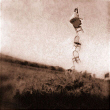
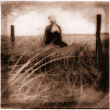
← return to index
Meghan Boody
Incident at the Reformatory, 1995
Meghan Boody created her
Incident at the Reformatory (1995) series of iris prints.
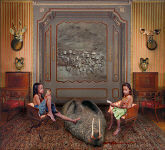
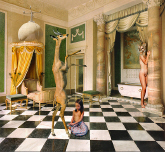
← return to index
Megapixel digital cameras
1997-1998
The first affordable 1.2-megapixel digital cameras arrived on the consumer market. Users who had a new PC were
able to easily connect these via fast new USB ports (in new PCs from 1997).
Cheap digital cameras & scanners meant new industries could emerge — such as the simplistic photocollage
involved in digital family 'scrapbooking', or the 'joke' face-morphing software.
More interestingly, a new fine art
Photoshop
-manipulated 'uncanny' portraiture
can be traced from David Lee's
Manimals series (1993) through to the portraits of Loretta Lux (2004).


← return to index
Interactive multimedia
Ceremony of Innocence; UK 1997
Ceremony of Innocence was Nick Bantock's interactive multimedia CD-ROM re-telling of his
Griffin & Sabine
series of books. The CD won around eight of the world's major digital media prizes.
Like many other innovative CD-ROM Director-based works, the disc no longer runs on modern
operating systems.
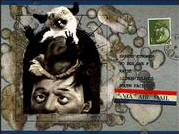
The rich possibilities of this sort of fantastic interactive storytelling have
been under-explored. The most interesting contemporary practitioner is
Dreaming Methods.
← return to index
Simen Johan
1997 onwards
Simen Johan created fabricated dream-nightmare scenarios enacted by his fictional
Photoshop
-built children,
using between 50 to 100 different elements per picture. His first series,
And Nothing Was to Be Trusted, was in
black and white, after which he has worked in colour.


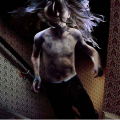
← return to index
Robert ParkeHarrison
The Architect's Brother, 1997 onwards
Robert ParkeHarrison's photomontaged
Earth Elegies and
Promisedland series — which appeared in book form as
The Architect's Brother in 2000
— used traditional darkroom photography, paper negatives and paint applied to the prints.
ParkeHarrison now works with his wife Shana, and
Photoshop
has become part of their working method.
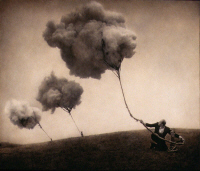
← return to index
Kahn+Selesnick
Fantastic histories, 1997 onwards
Nicholas Miles Kahn and Richard Selesnick are a British/American artist pair who use props and costumes, the new panorama-stitching software,
and Adobe
Photoshop
, to create cinematic psuedo-historical series of photographs. Their series include:
The Circular River (1997);
Scotlandfuturebog (2000);
City of Salt (2001);
The Apollo Prophecies (2004) and
Eisbergfreistadt (2007).



← return to index
Maggie Taylor
1998 onwards
Maggie Taylor — wife of Jerry Uelsmann — started working with flatbed scanners and Adobe
Photoshop
in 1996, and from
1998 produced a significant body of photomontages. Adobe later published the book
Maggie Taylor's Landscape of Dreams (2005),
and Taylor is currently illustrating Carroll's
Alice (2008).
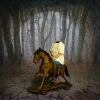

← return to index
Tom Chambers
1998 onwards
Tom Chambers has been creating surreal photomontages since 1998. He makes film images of elements, scans, and
completes the picture in
Photoshop
.



← return to index
Patrycja Orzechowska
1999 onwards
Well known in Poland, Patrycja Orzechowska (1974-) has created three series:
neoSurrealistic Landscape (1999);
Nos Duo (2004), and
Phantoms (2003-4).
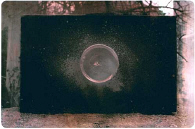

← return to index
Klaus Elle
1999 onwards
Klaus Elle seems to have created spirit-photography -like images around 1999, possibly with the aid of
Photoshop
.
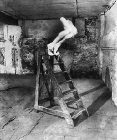
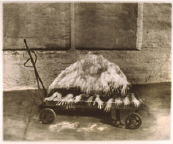
← return to index
Louviere+Vanessa
Slumberland, 1999 onwards?
U.S. husband and wife team Louviere+Vanessa have worked together since 1998, creating the
Slumberland series of dream-like images
with constructed scenes and darkroom manipulation. In 2006 they first showed the
Chloroform Series (example below).
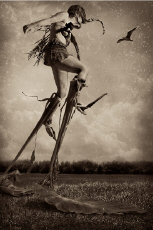
← return to index
Dominic Rouse
2000 onwards
British artist Rouse began making photomontage around 2000, and was soon creating ever-more ambitious works, Rouse creates digital negatives that he then prints in the darkroom as traditional silver gelatin prints.
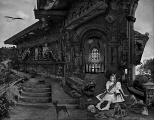
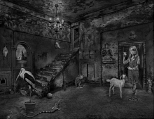
← return to index
Alessandro Bavari
Sodom and Gomorrah , 2000 onwards
Italian Alessandro Bavari seems to have begun creating advanced photmontages, the aid of the aid of
Photoshop
,
around 1995. His major body of work is the series
Sodom and Gomorrah (2000-2003).
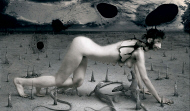
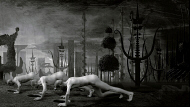
← return to index
Andrew Mamo
Are We Not Men? series, 2000
In Mamo's early work we see key nu-real themes; altered monstrous heads, levitating, and emulated antique processes.
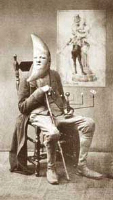

← return to index
Johann Fournier
La Porte Aquatique, 2000
Johann Fournier's
La Porte Aquatique series seems to have been made in 2000.



← return to index
Viktor Koen
Makers of Tlon series, 2000; and Transmigrations series, 2001
Viktor Koen's
Makers of Tlon was based on the the story "Tlon, Uqbar, Orbis Tertius" (1940; 1961 in English) by Jorge Luis Borges.



← return to index
A Vindication of Tlon
Photography and the Fantastic, 2001
Photography and the Fantastic was a week-long international exhibition, with workshops and a 148-page Greek/English book —
A Vindication of Tlon: Photography and the Fantastic —
at the Thessaloniki Museum of Photography in Greece in 2001.
The introductory essay to the accompanying book, by curator John Stathatos,
can be read online.

As the dust settled following the collapse of communism, the West began to learn
of dissident photographers and surreal artists (e.g.: Polish theatre posters).
← return to index
Photoshop compositing textbooks
compositing textbooks
Photoshop Masking & Compositing, 2002
Masking & Compositing, 2002
The first of the serious textbooks on how to use Adobe
Photoshop
for
advanced photomontage was published,
Photoshop Masking & Compositing
Masking & Compositing (2002), replacing the
out-of-date and basic
Photoshop Collage
Collage (1997). The 2002 book featured many images by Maggie Taylor and two by Jerry Uelsmann.
2004 saw the book
Adobe Master Class:
Photoshop Compositing with John Lund
Compositing with John Lund (2004)
and the first of two
Surreal Digital Photography (2004) tutorial-guides.

Photoshop

Compositing with John Lund" />
← return to index
Andrew Polushkin
Sweet Home Clinic, 2002 onwards
Working in St. Petersburg, Russia, Polushkin (1972-) seems to have begun fantastic photomontage with his uncompromising
Sweet Home Clinic series (2002-2006).
Self trained, he uses
Photoshop
and Painter.




← return to index
Mat Collishaw
Fairy series, circa 2003
Mat Collishaw, formerly a Britart artist, produced his
Sugar and Spice and
Fairy Stories series of photographs around 2003. They
appear to be produced by a combination of staging and
Photoshop
.
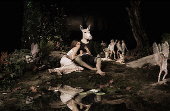
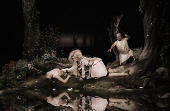
Schilte & Portielje
Beyond Reality series, circa 2003
Schilte & Portielje are a Dutch duo, who have shown in numerous galleries and museums, and who published a 90-page hardcover book
Photo Works Beyond Reality (Eigen Beheer) in 2003.



Micheal Harp
Warped Victorians, 2003 onwards
Micheal Harp uses public domain photographs from the Victorian and Edwardian eras, transforming them in
Photoshop
into comical/macabre figures from a Poe-esque and Lovecraft-ian parallel universe.
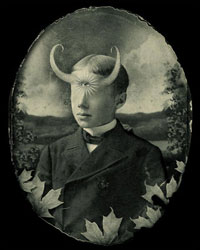
← return to index
Fredrik Odman
Composed Animals, after 2005?
Composed Animals is a small series of fictional animals, created by Danish photographer Fredrik Odman. Probably
created after 2005(?).
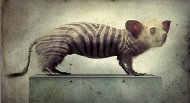
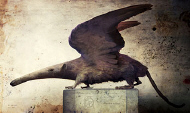
← return to index
Charlotte Corey
The Visitors, after 2005?
The Visitors is a series of 12 recombinations of Victorian carte-de-visites with Victorian photographs of stuffed animals,
created by British photographer Charlotte Corey. Probably created after 2005(?), and published in book form by Dewi Lewis in 2007.
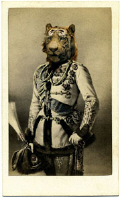
← return to index
Oscar Guzman
The City of Galvez, 2005/6
The City of Galvez is a 16-image photmontaged series that premiered on the ZoneZero photography website in
early 2006. Obviously influenced by fantasy invented-worlds computer games such as
Myst,
Uru and
Morrowind, Guzman's mythical
city is perhaps also influenced by the cities found in fantastic fiction such as Calvino and Borges. His city is inhabited by bowler-hatted
men in suits, which seems to be a nod toward the paintings of Magritte, and the look of the city itself a nod toward Gaudi.
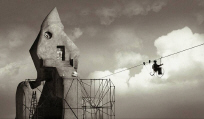
← return to index
Craig Parker
after 2005?
South African Craig Parker produced a 12-photo series circa 2005.
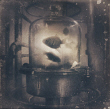
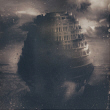


← return to index
Lars Henkel
after 2005?
German Lars Henkel has produced a large body of photomontaged work, and has also produced pop videos
in the same style.
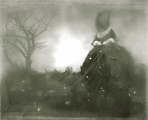
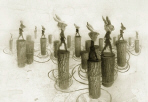
← return to index
Mikko Rantanen
after 2005?
Mikko Rantanen is a Finnish D&AD-nominated artist and illustrator.
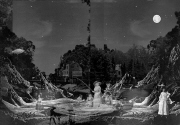
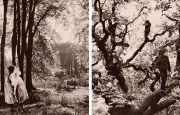
← return to index
Chris Anthony
Victims and Avengers, 2005/6
Victims and Avengers is a 24-image series by Chris Anthony. Using panoramic cameras and
Photoshop
, he creates menacing interior tableaux.



← return to index
Mick Ryan
Fables series, after 2005?
Ryan studied photography in Ireland. He now lives in Shanghai, China. His
Fables series
shows influences from Carroll's
Xie series and surrealism.
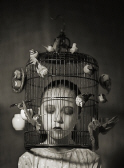


← return to index
Joseph Mills
Loves of the Poets
Joseph Mills (1951-) apparently made his photomontages in the late 1980s; but has only recently
published these as the photomontage collection
Loves of the Poets (2005), followed by
Anarch (2007).
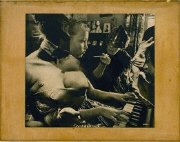

← return to index
Bogdan Zwir
after 2005?
Zwir is a Russian protographer. Her 'wrapped heads' pictures seem to be influenced by Magritte.




← return to index
Darren Holmes
after 2005?
Holmes has only created a few pictures in the nu-real style, but his triptych is especially interesting.


← return to index
Anke Merzbach
after 2005?
German photographer Merzbach seems to have started making seamless photomontage in 2005 or 2006.

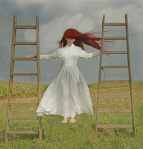
← return to index
Berenika Haladova
Personal work, after 2005?
Polish photographer Berenika Haladova creates personal, feminine, dreamlike pictures, often with very simple scenes and props.


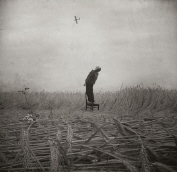
← return to index
Kamil Vojnar
Personal work, after 2005?
Czech photographer Kamil Vojnar is obviously aware of spirit photography, as evidenced by the levitating glass.
Young angels and personal levitation are also much in evidence.



← return to index
Darek Siatkowski
Naked Human series, after 2005?
Polish photographer Darek Siatkowski's
Naked Human series uses complex double-exposures, projections and transparent acetates.
His use of 'the room as frame' seems to be influenced by Saudek.


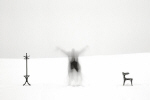
← return to index
Roksana Mical (Wrenda)
Playround series, 2005? - ongoing
Polish photographer Mical's
Playround series uses simple staging and occasional
Photoshop
.




← return to index
Stephen Rothwell
Various series, 2005? - ongoing
British artist Stephen Rothwell produces highly polished and accomplished photomontage series, from 2005? onwards.



← return to index
Cole Rise
Weight of Our Bodies, after 2005?
Young U.S. photographer Cole Rise, who posts on Flickr as 'antimethod' and runs Flagr.com, states in an interview that he takes
his personal levitation/flying theme from skateboarding, fantasy computer-games and
The Matrix — rather than from Lartigue and spirit photography.


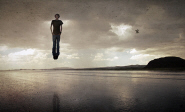
← return to index
Erwin Olaf
Various series, some composited
Although obviously much in demand by the couture fashion world, it seems impossible to
classify Olaf as 'only a fashion photographer'. His work, although highly polished, has an authentic dark frisson that lasts beyond the surface impression.
His 1996 Witkin-inspired
Chessmen series (b&w, below), although staged, may well have influenced the nu-real artists such as Rouse and Bavari.




← return to index
Tina Winkhaus
Hope series, some composited
In Winkhaus' series such as
Hope, she created a dark narrative that departs from her lighter fashion-oriented work, and which references Symbolist painting.


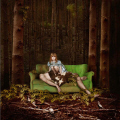
← return to index
Cyril Helnwein
The Ethereal series
The son of the German master-painter and photographer Gottfried Helnwein, Cyril's 2005? series
The Ethereal referenced spirit photography, gothic literature and antique processes.
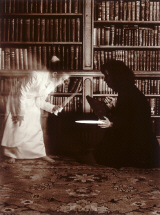
← return to index
Fashion photography
Fashion photography takes up nu-real, after 2005?
The mayflies of fashion photography start to more frequently take onboard some nu-real themes and approaches, and do them with all the panache, lighting, costumes and large budgets
of couture fashion photography. Although highly polished, most attempts appear slapped together and lack depth; but in recent years Eugenio Recuenco is especially notable for his
Madame Figaro and
Dreams series (both 2006?).

In her last years of life (circa 2005) Annie Leibovitz created an elaborate tableaux / photomontaged set
for
Vogue illustrating
The Wizard of Oz.
← return to index
David Noonan
Silkscreen series, 2006/7
It seems that Noonan began to create his signature multiple-exposure silkscreen works in 2006.


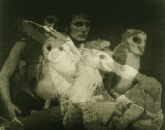
← return to index
Daniele Cascone
Houses series, 2007
Italian Daniele Cascone (1977-) is the editor of
Brain Twisting and creates polished personal fantasy work that blends photography with illustration.



← return to index
Peter Plagens, 2007
Art critic Peter Plagens, in an article in
Newsweek magazine, ponders what might have caused...
"photography's flight into fable" ... "a
Photoshop fairy tale, containing only a tiny trace of a small fragment of reality."
fairy tale, containing only a tiny trace of a small fragment of reality."
← return to index



















 'Hypnotised and suspended' (c. 1901)...
'Hypnotised and suspended' (c. 1901)...













 Interestingly, Dali told Hitchcock (for Spellbound, 1945) that dreams in film should
be portrayed in a sharp focus, rather than by using the then-typical 'soft-focus and fog' approach.
Interestingly, Dali told Hitchcock (for Spellbound, 1945) that dreams in film should
be portrayed in a sharp focus, rather than by using the then-typical 'soft-focus and fog' approach.

 Ernst's collage work particularly influenced artists such as Jindrich Styrsky (1899-1942) and
Joseph Cornell (1903-1972).
Ernst's collage work particularly influenced artists such as Jindrich Styrsky (1899-1942) and
Joseph Cornell (1903-1972).


 This 'eyes' picture by Valentin was published in the avante-garde art magazine Varietes; Belgium, 1929.
This 'eyes' picture by Valentin was published in the avante-garde art magazine Varietes; Belgium, 1929.
 In 1930, Aragon wrote an essay, for a retrospective show in Paris of collage works, in which he deplored the lack of critical interest in collage activity.
In 1930, Aragon wrote an essay, for a retrospective show in Paris of collage works, in which he deplored the lack of critical interest in collage activity.
 On 6th-10th May 1933 the library of the Institut fur Sexualwissenschaft was burned on the Opernplatz in Berlin — the first of many
Nazi book burnings.
On 6th-10th May 1933 the library of the Institut fur Sexualwissenschaft was burned on the Opernplatz in Berlin — the first of many
Nazi book burnings.























 See: Georges Hugnet: Collages (168 color and b&w illustrations), published in Paris in 2003.
See: Georges Hugnet: Collages (168 color and b&w illustrations), published in Paris in 2003.






 Interestingly this narrative storytelling form recalled a form of popular culture — the comic strip — which had been
one of the few easily-available sources of 'the visual fantastic' during the 1950s and 1960s. The form had also been used by Magritte (Man with a Newspaper, 1928). Michals' early photographic sequences
were published in book form as Sequences in 1970.
Interestingly this narrative storytelling form recalled a form of popular culture — the comic strip — which had been
one of the few easily-available sources of 'the visual fantastic' during the 1950s and 1960s. The form had also been used by Magritte (Man with a Newspaper, 1928). Michals' early photographic sequences
were published in book form as Sequences in 1970.









 + Angela Carter published her translation of The Fairy Tales of Charles Perrault (1977), and
her book of dark fairy stories The Bloody Chamber (1979).
+ Angela Carter published her translation of The Fairy Tales of Charles Perrault (1977), and
her book of dark fairy stories The Bloody Chamber (1979).

 In 1979 Derek Jarman released the feature-film The Tempest, a gothic work whose ending nevertheless
borrows from the camp tableaux photography of Pierre et Gilles. Jarman went on to play a major role
in the establishment of that most queer and often fantastic experimental medium, the pop video.
The rediscovery of Eisenstein (a gay man, who invented a new cinematic language of fast montage)
in France in the 1970s may also have influenced the pop video.
In 1979 Derek Jarman released the feature-film The Tempest, a gothic work whose ending nevertheless
borrows from the camp tableaux photography of Pierre et Gilles. Jarman went on to play a major role
in the establishment of that most queer and often fantastic experimental medium, the pop video.
The rediscovery of Eisenstein (a gay man, who invented a new cinematic language of fast montage)
in France in the 1970s may also have influenced the pop video.
 Staged photography: From around 1980, until the fall of the Berlin Wall, there was a
wave of 'staged' (often dream-like/absurdist) photography made (although not always widely seen) across Eastern Europe.
A more leaden and ideology-freighted staged photography was explored in Western Europe & the U.S. during the 1980s.
During the late 1980s and 90s fashion photography began to make inventive staged photography, on large budgets.
Staged photography: From around 1980, until the fall of the Berlin Wall, there was a
wave of 'staged' (often dream-like/absurdist) photography made (although not always widely seen) across Eastern Europe.
A more leaden and ideology-freighted staged photography was explored in Western Europe & the U.S. during the 1980s.
During the late 1980s and 90s fashion photography began to make inventive staged photography, on large budgets.







 + From 1985 Francesca Woodman's photography becomes known in the U.S.
+ From 1985 Francesca Woodman's photography becomes known in the U.S.

 In this regard, the work of Ray Caesar points to a future when 'photo-real' tableaux
may be easily created in computer-game -like software rather than starting in a camera.
In this regard, the work of Ray Caesar points to a future when 'photo-real' tableaux
may be easily created in computer-game -like software rather than starting in a camera.
 with layers
with layers version 3.0, Nov 1994
version 3.0, Nov 1994 Photoshop
Photoshop





 The rich possibilities of this sort of fantastic interactive storytelling have
been under-explored. The most interesting contemporary practitioner is
Dreaming Methods.
The rich possibilities of this sort of fantastic interactive storytelling have
been under-explored. The most interesting contemporary practitioner is
Dreaming Methods.



























 As the dust settled following the collapse of communism, the West began to learn
of dissident photographers and surreal artists (e.g.: Polish theatre posters).
As the dust settled following the collapse of communism, the West began to learn
of dissident photographers and surreal artists (e.g.: Polish theatre posters).
 compositing textbooks
compositing textbooks Masking & Compositing, 2002
Masking & Compositing, 2002 Photoshop
Photoshop
































































 In her last years of life (circa 2005) Annie Leibovitz created an elaborate tableaux / photomontaged set
for Vogue illustrating The Wizard of Oz.
In her last years of life (circa 2005) Annie Leibovitz created an elaborate tableaux / photomontaged set
for Vogue illustrating The Wizard of Oz.





